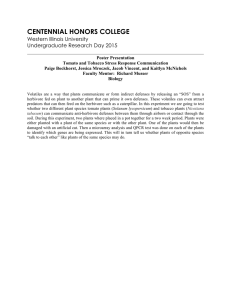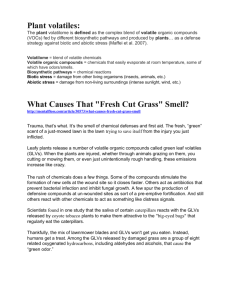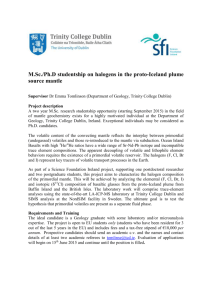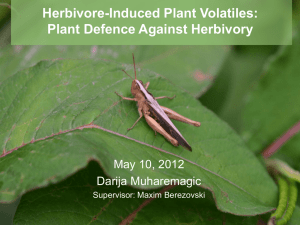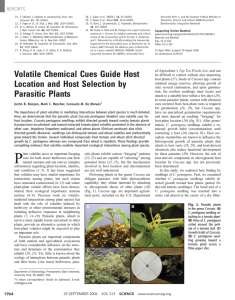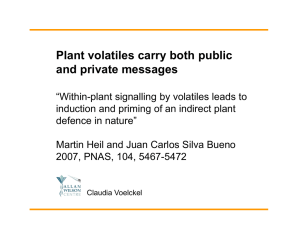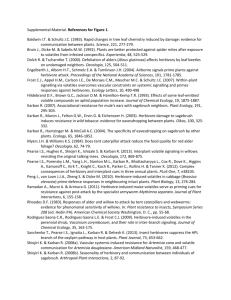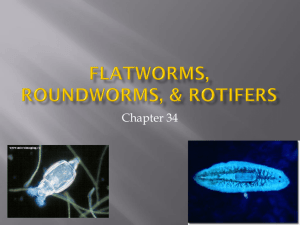Plant Host Finding by Parasitic Plants Addendum Mark C. Mescher
advertisement
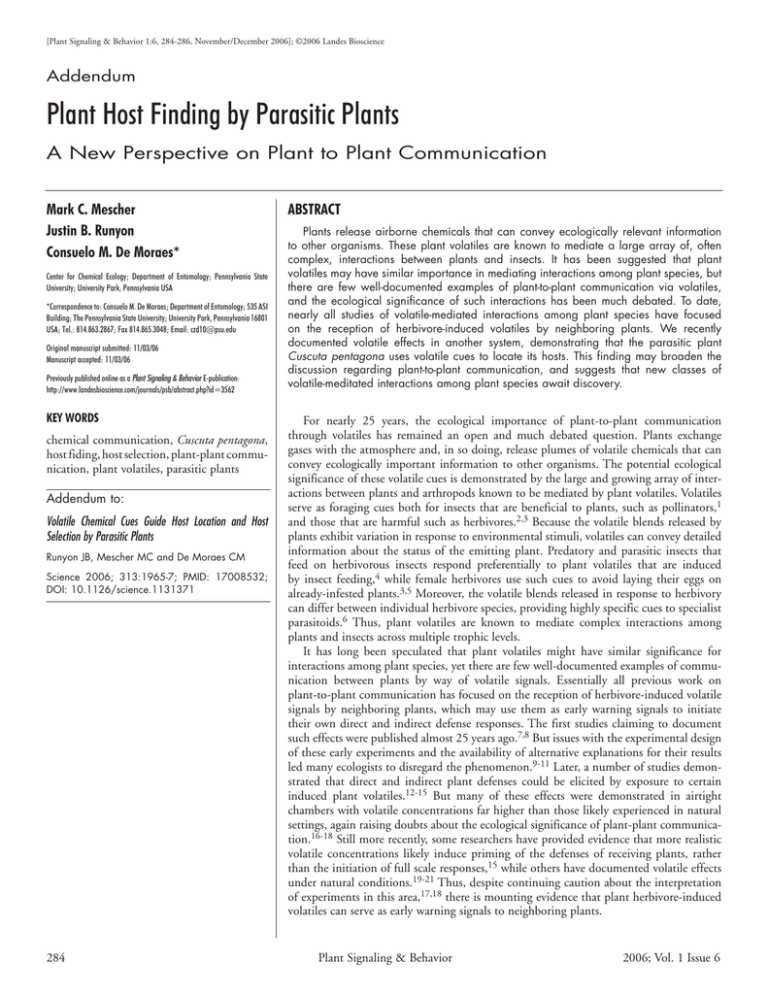
[Plant Signaling & Behavior 1:6, 284-286, November/December 2006]; ©2006 Landes Bioscience Addendum Plant Host Finding by Parasitic Plants A New Perspective on Plant to Plant Communication Mark C. Mescher Justin B. Runyon Consuelo M. De Moraes* Center for Chemical Ecology; Department of Entomology; Pennsylvania State University; University Park, Pennsylvania USA *Correspondence to: Consuelo M. De Moraes; Department of Entomology; 535 ASI Building; The Pennsylvania State University; University Park, Pennsylvania 16801 USA; Tel.: 814.863.2867; Fax 814.865.3048; Email: czd10@psu.edu Original manuscript submitted: 11/03/06 Manuscript accepted: 11/03/06 Previously published online as a Plant Signaling & Behavior E-publication: http://www.landesbioscience.com/journals/psb/abstract.php?id=3562 Key words chemical communication, Cuscuta pentagona, host fiding, host selection, plant-plant communication, plant volatiles, parasitic plants Addendum to: Volatile Chemical Cues Guide Host Location and Host Selection by Parasitic Plants Runyon JB, Mescher MC and De Moraes CM Science 2006; 313:1965-7; PMID: 17008532; DOI: 10.1126/science.1131371 284 Abstract Plants release airborne chemicals that can convey ecologically relevant information to other organisms. These plant volatiles are known to mediate a large array of, often complex, interactions between plants and insects. It has been suggested that plant volatiles may have similar importance in mediating interactions among plant species, but there are few well‑documented examples of plant‑to‑plant communication via volatiles, and the ecological significance of such interactions has been much debated. To date, nearly all studies of volatile‑mediated interactions among plant species have focused on the reception of herbivore-induced volatiles by neighboring plants. We recently documented volatile effects in another system, demonstrating that the parasitic plant Cuscuta pentagona uses volatile cues to locate its hosts. This finding may broaden the discussion regarding plant‑to‑plant communication, and suggests that new classes of volatile‑meditated interactions among plant species await discovery. For nearly 25 years, the ecological importance of plant‑to‑plant communication through volatiles has remained an open and much debated question. Plants exchange gases with the atmosphere and, in so doing, release plumes of volatile chemicals that can convey ecologically important information to other organisms. The potential ecological significance of these volatile cues is demonstrated by the large and growing array of interactions between plants and arthropods known to be mediated by plant volatiles. Volatiles serve as foraging cues both for insects that are beneficial to plants, such as pollinators,1 and those that are harmful such as herbivores.2,3 Because the volatile blends released by plants exhibit variation in response to environmental stimuli, volatiles can convey detailed information about the status of the emitting plant. Predatory and parasitic insects that feed on herbivorous insects respond preferentially to plant volatiles that are induced by insect feeding,4 while female herbivores use such cues to avoid laying their eggs on already‑infested plants.3,5 Moreover, the volatile blends released in response to herbivory can differ between individual herbivore species, providing highly specific cues to specialist parasitoids.6 Thus, plant volatiles are known to mediate complex interactions among plants and insects across multiple trophic levels. It has long been speculated that plant volatiles might have similar significance for interactions among plant species, yet there are few well‑documented examples of communication between plants by way of volatile signals. Essentially all previous work on plant‑to‑plant communication has focused on the reception of herbivore-induced volatile signals by neighboring plants, which may use them as early warning signals to initiate their own direct and indirect defense responses. The first studies claiming to document such effects were published almost 25 years ago.7,8 But issues with the experimental design of these early experiments and the availability of alternative explanations for their results led many ecologists to disregard the phenomenon.9‑11 Later, a number of studies demonstrated that direct and indirect plant defenses could be elicited by exposure to certain induced plant volatiles.12‑15 But many of these effects were demonstrated in airtight chambers with volatile concentrations far higher than those likely experienced in natural settings, again raising doubts about the ecological significance of plant‑plant communication.16‑18 Still more recently, some researchers have provided evidence that more realistic volatile concentrations likely induce priming of the defenses of receiving plants, rather than the initiation of full scale responses,15 while others have documented volatile effects under natural conditions.19‑21 Thus, despite continuing caution about the interpretation of experiments in this area,17,18 there is mounting evidence that plant herbivore-induced volatiles can serve as early warning signals to neighboring plants. Plant Signaling & Behavior 2006; Vol. 1 Issue 6 Plant Host Finding by Parasitic Plants Figure 1. Seedling of Cuscuta pentagona (A) foraging toward a 20‑day‑old tomato plant, (B) attaching to and beginning to grow from stems of tomato seedlings and (C) close up of C. pentagona attachment. We recently documented an entirely new class of volatile mediated interactions among plants: the role of plant volatiles in host location by parasitic plants that attach to above ground shoots of other plants. Plant parasites are important components of natural and agricultural ecosystems and play important roles in determining community structure and dynamics.22,23 We are exploring the mechanisms of host‑location and other interactions between parasitic plants in the genus Cuscuta (dodder) and their host plants. Dodder vines germinate from seeds containing limited energy reserves and, as the parasites have no roots and little photosynthetic ability, must quickly locate and attach to suitable hosts in order to survive (Fig. 1). Thus, there is presumably significant selection pressure for dodder vines to employ efficient strategies for host location, and host plant volatiles may be expected to provide relevant directional cues. Dodder seedlings exhibit a rotational growth habit (circumnutation) following germination and previous researchers have suggested that host‑finding might involve random growth24 or the exploitation of light cues.25 Using a very simple experimental design, we explored the possibility that host‑plant volatiles might mediate host‑location by seedlings of C. pentagona. We placed a germinated seedling in a vial of water located at the center of a dry filter paper disk. A host plant (a 20‑day old tomato seedling) was placed near the edge of the disk and the dodder seedling was allowed to forage for four days. By the end of the experiment the seedling would lay horizontally on the disk and we traced its position on the filter paper in order to assess the directionality of growth relative to the host plant. This experiment was replicated 30 times and our results clearly indicated directional growth toward the tomato plant (80% of the tested seedlings grew into the disk half nearest the host) demonstrating that C. pentagona seedlings were perceiving some host‑derived cue. www.landesbioscience.com We did not observe directed growth when we tested dodder seedling response to alternative targets including pots of moist soil, artificial plants, and vials of colored water intended to mimic possible light cues. In order to confirm a role for plant volatiles in host location by C. pentagona, we tested seedling response to host plant volatiles extracted from filtered air in a volatile collection system and then released from rubber septa in the absence of any other host‑ derived cues. Here we observed a directed growth response similar to that exhibited toward an intact tomato seedling, confirming that host plant volatiles do provide a cue used for host location by C. pentagona. In subsequent experiments we found directed growth toward impatiens and alfalfa plants, which are attractive hosts for C. pentagona and also toward wheat plants which are poor hosts, suggesting that the host‑location mechanisms operate over a wide range of host species. Since discriminating between more and less desirable host species is likely to be important in natural settings, we next explored whether dodder seedlings could distinguish volatile signals from host and nonhost plants. Cuscuta pentagona seedlings exhibited directional growth toward tomato plants in preference to wheat plants and also to extracted volatiles from tomato in preference to those from wheat, demonstrating an ability to distinguish and choose among volatiles from more and less preferred hosts. When we tested seedling responses to individual compounds from the wheat and tomato blends, we found that three compounds from tomato, a‑pinene, b‑myrcene, and b‑phellandrene elicited directed growth. b‑myrcene was also present in the wheat blend. Unexpectedly, we also found that one compound present in the wheat blend, (Z)‑3‑hexenyl acetate, was repellent, providing a plausible explanation for the lower attractiveness of the wheat blend. It is interesting to note that (Z)‑3‑hexenyl acetate is also released by tomato in response to feeding by herbivores, and we have some data suggesting that C. pentagona seedlings may find tomato seedlings infested by Heliothis virescens caterpillars less attractive than un‑attacked plants (unpublished data). The discovery that some parasitic plants exploit host plant volatiles for host location provides a new perspective on volatile mediated interactions among plant species, demonstrating that plant volatiles play a role in mediating ecologically significant interactions in at least one system other than the transfer of herbivore-induced warning signals. We think it is quite likely that plant volatiles will be found to play a role in host location by other parasitic plants and perhaps even by vining plants generally. Moreover, we think it is more likely than not that more classes of volatile mediated interactions among plants remain to be discovered given the potential availability of volatile cues and the fitness benefits to be derived by plants using such cues to gather information about the identity and condition of their neighbors. Cancer Biology & Therapy 285 Plant Host Finding by Parasitic Plants References 1. Kaiser R. Flowers and fungi use scents to mimic each other. Science 2006; 311:806‑7. 2. Bernays EA, Chapman RF. Host‑plant selection by phytophagous insects. New York: Chapman and Hall, 1994. 3. De Moraes CM, Mescher MC, Tumlinson JH. Caterpillar‑induced nocturnal plant volatiles repel conspecific females. Nature 2001; 410:577‑80. 4. Turlings TCJ, Tumlinson JH, Lewis WJ. Exploitation of herbivore-induced plant odors by host‑seeking parasitic wasps. Science 1990; 250:1251‑3. 5. Kessler A, Baldwin IT. Defensive function of herbivore-induced plant volatile emissions in nature. Science 2001; 291:2141‑4. 6. De Moraes CM, Lewis WJ, Pare PW, Alborn HT, Tumlinson JH. Herbivore-infested plants selectively attract parasitoids. Nature 1998; 393:570‑3. 7. Rhoades DF. Responses of alder and willow to attack by tent caterpillars and webworms ‑ Evidence for pheromonal sensitivity in willows. In: Hedin PA, ed. Plant Resistance to Insects. Washington, DC: American Chemical Society Symposium Series 208, 1983:55‑68. 8. Baldwin IT, Schultz JC. Rapid changes in tree leaf chemistry induced by damage: Evidence for communication between plants. Science 1983; 221:277‑9. 9. Dicke M, Agrawal AA, Bruin J. Plants talk, but are they deaf? Trends Plant Sci 2003; 8:403‑5. 10. Fowler SV, Lawton JH. Rapidly induced defenses and talking trees: The devil’s advocate position. Am Nat 1985; 126:181‑95. 11. Karban R, Baldwin IT. Induced responses to herbivory. Chicago, IL: University of Chicago Press, 1997. 12. Farmer EE, Ryan CA. Interplant communication: Airborne methyl jasmonate induces synthesis of proteinase inhibitors in plant leaves. P Natl Acad Sci USA 1990; 87:7713‑6. 13. Arimura G, Ozawa R, Shimoda T, Nishioka T, Boland W, Takabyashi J. Herbivory‑induced volatiles elicit defence genes in lima bean leaves. Nature 2000; 406:512‑5. 14. Karban R, Maron J, Felton GW, Ervin G, Eichenseer H. Herbivore damage to sagebrush induces resistance in wild tobacco: Evidence for eavesdropping between plants. Oikos 2003; 100:325‑32. 15. Engelberth J, Alborn HT, Schmelz EA, Tumlinson JH. Airborne signals prime plants against insect herbivore attack. P Natl Acad Sci 2004; 101:1781‑5. 16. Paschold A, Halitschke R, Baldwin IT. Using ‘mute’ plants to translate volatile signals. Plant J 2006; 45:275‑91. 17. Baldwin IT, Halitschke R, Paschold A, von Dahl CC, Preston CA. Volatile signaling in plant‑plant interactions: “Talking trees” in the genomics era. Science 2006; 311:812‑5. 18. Kessler A, Halitschke R, Diezel C, Baldwin IT. Priming of plant defense responses in nature by airborne signaling between Artemisia tridentata and Nicotiana attenuata. Oecologia 2006; 148:280‑92. 19. Karban R. Communication between sagebrush and wild tobacco in the field. Biochem Syst Ecol 2001; 29:995‑1005. 20. Shiojiri K, Karban R. Plant age, communication, and resistance to herbivores: Young sagebrush plants are better emitters and receivers. Oecologia 2006; 149:214‑20. 21. Karban R, Shiojiri K, Huntzinger M, McCall AC. Damage‑induced resistance in sagebrush: Volatiles are key to intra‑ and interplant communication. Ecology 2006; 87:922‑30. 22. Press MC, Phoenix GK. Impacts of parasitic plants on natural communities. New Phytologist 2005; 166:737‑51. 23. Bardgett RD, Smith RS, Shiel RS, Peacock S, Simkin JM, Quirk H, Hobbs PJ. Parasitic plants indirectly regulate below‑ground properties in grassland ecosystems. Nature 2006; 439:969‑72. 24. Dawson JH, Musselman LJ, Wolswinkel P, Dörr I. Biology and control of Cuscuta. Rev Weed Sci 1994; 6:265‑317. 25. Benvenuti S, Dinelli G, Bonetti A, Catizone P. Germination ecology, emergence and host detection in Cuscuta campestris. Weed Res 2005; 45:270‑8. 286 Plant Signaling & Behavior 2006; Vol. 1 Issue 6
